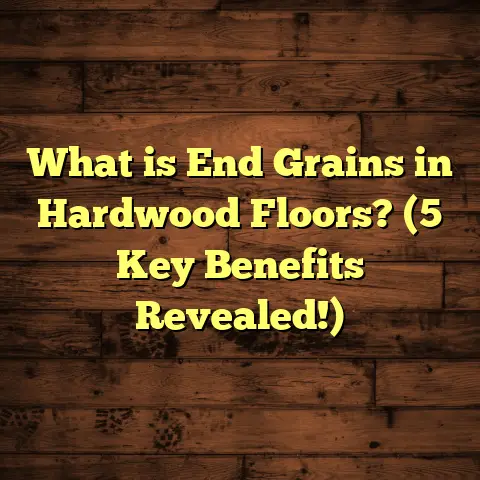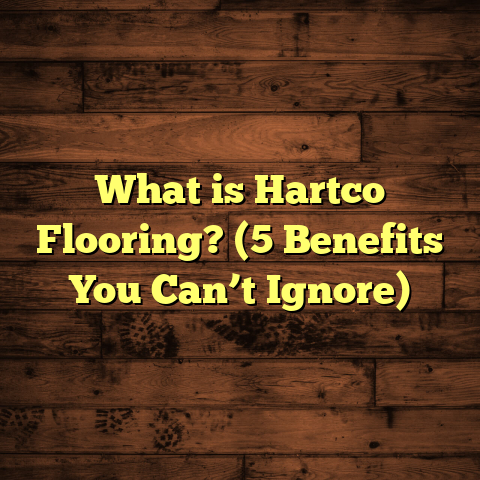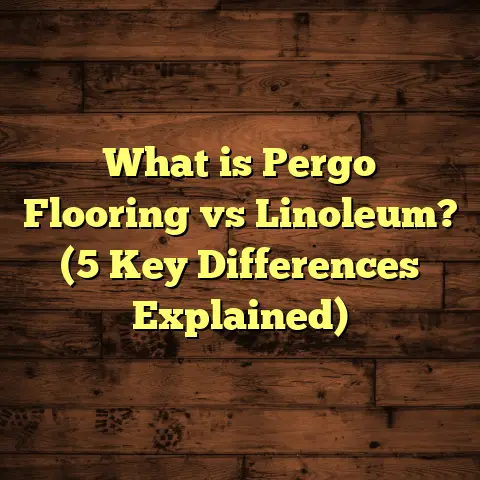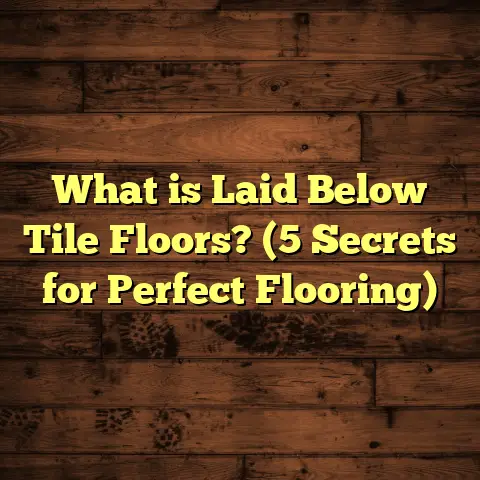What is Solid Wood Flooring? (5 Key Benefits You Need to Know)
Focusing on Bold Designs
You know, when I first started working with homeowners and designers, I quickly realized that flooring isn’t just something you walk on—it’s a bold design statement. It sets the stage for everything else in a room. Over the years, solid wood flooring has been my go-to recommendation for clients who want floors that make a lasting impression. It’s not just about looks, either. The texture, the warmth, and the character that solid wood brings to a space can’t be beat.
I’ve seen trends come and go—vinyl planks that mimic wood, carpet styles that promise comfort, engineered floors claiming to combine beauty and practicality—but solid wood flooring always holds its ground. So what is it exactly, and why does it keep winning people over? Let me walk you through everything I know from years of installing and living with solid wood floors.
What is Solid Wood Flooring?
Solid wood flooring is made from a single piece of hardwood, cut directly from trees like oak, maple, cherry, or walnut. Each plank is one solid piece of wood—no layers, no glued parts. This differs from engineered wood flooring, which has a thin veneer of real wood over plywood or fiberboard layers, and laminate flooring, which is a photographic layer over fiberboard.
The thickness of solid wood planks usually ranges around 3/4 inch (about 19mm). This thickness is key because it means you can sand and refinish the floor multiple times over its lifetime. That’s a huge advantage if you want your floors to last decades or even centuries.
Because each plank is a natural piece of wood, every board has unique grain patterns, knots, and color variations. This natural variation is part of the charm and character. When you walk on solid wood floors, you’re literally walking on the story of a tree that grew for decades—sometimes centuries.
How Solid Wood Flooring Is Made
I always like to share this little behind-the-scenes detail with clients who are curious. The process starts with harvesting logs from sustainable forests. The logs are cut into large slabs called boards or planks. After drying to reduce moisture content (which is critical to prevent warping), the boards are milled into flooring planks.
At this stage, they’re also sorted by quality and appearance. Some species have wide grain patterns; others are tighter and more uniform. Then the planks get finished with stains or clear coats depending on the desired look.
One thing I’ve noticed over time is how different finishes can completely change the vibe of solid wood floors. A matte finish feels rustic and natural, while a high gloss finish reflects light and adds elegance.
Comparing Flooring Options: What I’ve Tried and What Works
Over my career as a flooring contractor, I’ve installed all sorts of floors: tile, carpet, laminate, engineered wood, vinyl planks—you name it. But solid wood floors have a special place in my toolkit.
Let me share some comparisons based on my experience:
Engineered Hardwood vs. Solid Wood
Engineered hardwood is great for places where moisture is a concern—like basements or kitchens—because its plywood core reduces expansion and contraction. It’s also easier to install in some cases because it can be floated over subfloors.
However, engineered hardwood has a thinner top layer of real wood—usually 2 to 5 millimeters thick—so it can only be refinished once or twice before you hit the plywood underneath. Solid wood can be sanded many more times because it’s such a thick plank.
I remember working on a project where the homeowner wanted hardwood in their basement. We chose engineered wood for stability but later installed solid wood on the upper floors to get that classic look and longevity.
Laminate Flooring vs. Solid Wood
Laminate tends to be much more affordable and resistant to scratches and dents because it has a tough wear layer. It’s also easier to clean and install as a DIY project.
But laminate doesn’t have the authentic feel of real wood underfoot. It can look convincing from a distance but lacks warmth and depth when you get close.
I installed laminate in a rental property once to save costs and speed up the project. It worked fine for durability but I missed the natural warmth I get with solid wood in my own home.
Vinyl Plank Flooring vs. Solid Wood
Vinyl plank flooring has come a long way with realistic wood-look designs that are waterproof and easy to maintain. For high-traffic commercial spaces or homes with pets and kids, vinyl is often a practical choice.
Yet for me personally, vinyl never achieves the same aesthetic impact as solid wood. When clients want their homes to have real personality and style that lasts, I steer them towards solid wood.
Five Key Benefits of Solid Wood Flooring
Okay, now let’s get into the heart of why I love solid wood flooring so much—and why it might be perfect for you.
1. Durability That Lasts Generations
If you ask me what sets solid wood apart from other flooring types, durability is at the top of my list. Thanks to its thickness—usually around 3/4 inch—solid wood can be sanded down multiple times across its lifespan.
I’ve refinished floors that were originally installed over half a century ago. Those floors still looked fantastic after three or four sandings.
Here’s some data: According to the National Wood Flooring Association (NWFA), solid hardwood floors can last over 100 years if maintained properly. That’s something no laminate or vinyl product can match.
A lot of my clients appreciate knowing they’re making an investment that won’t need replacing in 10 or 15 years. Instead, with proper care, their floors’ll just get better with age.
2. Natural Beauty and Unique Grain Patterns
The look of solid wood floors really can’t be replicated by synthetic materials. Each plank has its own unique grain pattern, knots, and color variations because it comes from an actual tree.
I worked on a project where we used reclaimed oak beams milled into flooring planks. The character in those boards—the marks from decades ago—added such personality to the space that no new material could match.
Some species like hickory or walnut have bold grains that create striking visuals; others like maple or cherry offer subtle elegance.
The finish choice also plays a big role: clear finishes highlight natural colors; stains let you customize tones from light blondes to deep espresso browns.
I often tell clients: “Think of your floor as a piece of art underfoot.” The natural variation means no two rooms will ever look exactly alike.
3. Increased Home Value
Solid wood flooring has long been known as a value booster when selling homes. According to data from Zillow and Realtor.com, homes with hardwood floors tend to sell for 2-3% more on average than comparable homes without them.
In my experience working with real estate agents and homeowners on staging projects, hardwood floors consistently attract more buyers—and often faster offers.
One homeowner I worked with was debating between installing carpet or solid hardwood in their living room before putting their house on the market. They chose hardwood, and within weeks they had multiple offers over asking price.
Hardwood floors suggest quality craftsmanship and timeless style to buyers—a great return on investment.
4. Improved Indoor Air Quality
This is something I didn’t fully appreciate until working with families who had allergies or asthma issues.
Carpet traps dust mites, pet dander, pollen, mold spores—you name it—which can worsen respiratory problems. Solid wood floors are easy to clean regularly with sweeping or vacuuming.
I remember one client telling me how switching from carpet to hardwood in their kids’ bedrooms reduced allergy symptoms significantly.
With hardwood floors, there’s less chance for allergens to build up because dirt doesn’t get embedded deep like it does in carpets.
So if anyone in your household struggles with allergies or respiratory concerns, solid hardwood might be worth considering for healthier indoor air quality.
5. Eco-Friendly and Sustainable Choice
Sustainability is increasingly important when choosing building materials.
Solid wood flooring sourced from responsibly managed forests certified by organizations like the Forest Stewardship Council (FSC) supports environmental stewardship by ensuring trees are harvested sustainably.
I’ve partnered with suppliers who offer reclaimed hardwood—planks salvaged from old barns or factories—that give new life to beautiful aged wood while reducing landfill waste.
There’s something special about walking on reclaimed wood knowing you’re preserving history while protecting future forests.
Even new solid wood flooring manufacturers increasingly emphasize responsible forestry practices as part of their mission.
What Makes Solid Wood Flooring Installation Different?
Installing solid wood flooring comes with some unique challenges compared to laminate or engineered products.
Acclimation Is Key
Solid wood expands and contracts based on humidity levels—it breathes like any natural material. Before installation, it’s crucial to let planks acclimate in your home for several days so they adjust to local moisture conditions.
On one humid coastal project I handled, we ordered the planks early so they could sit inside the house for almost a week before laying them down. This prevented major expansion problems afterward.
Subfloor Preparation
The subfloor needs to be flat, clean, dry, and structurally sound before installation starts. Uneven surfaces can cause squeaks or damage over time.
I always remind clients that spending extra time upfront preparing the subfloor saves headaches later on.
Installation Methods
Solid wood typically gets nailed or stapled down onto wooden subfloors but can sometimes be glued depending on substrate type and product specs.
Floating installations aren’t common with solid hardwood because it needs firm attachment due to its weight and expansion properties.
Finishing Options Onsite
If unfinished planks are used (which are often cheaper), sanding and finishing happen after installation for a seamless look tailored exactly to your style preferences.
This approach requires skilled labor but allows more customization than prefinished planks.
How I Use FloorTally for Cost Estimation
Budgeting for solid wood floors can be tricky because costs vary widely based on species, finish type, labor rates in your area, room size, waste factor, and more.
I use FloorTally regularly—a tool that helps me get accurate estimates by pulling local prices for materials and labor automatically.
It saves me time by consolidating calculations in one place rather than calling multiple suppliers or contractors for quotes.
For example: For a typical 300-square-foot living room using red oak prefinished flooring in my region—
- Material cost runs about $5–$8 per square foot
- Installation labor adds roughly $3–$6 per square foot
- Waste factor usually adds around 5–10% extra material needed
FloorTally calculates all this quickly so I can present clients with realistic budgets upfront instead of guesswork.
This transparency helps clients plan better financially—and reduces surprises mid-project.
Common Challenges I’ve Encountered
No material is perfect—even solid wood flooring has some downsides depending on your situation:
Moisture Sensitivity
Wood naturally reacts to moisture changes by expanding or contracting—sometimes causing gaps between boards or cupping (boards warping upward).
This means solid hardwood isn’t ideal for areas prone to high humidity or water spills unless precautions are taken (like good ventilation or using engineered wood instead).
Maintenance Requirements
While durable, solid wood floors do need periodic care—a few tips:
- Avoid excessive water during cleaning (use damp mop only)
- Use felt pads under furniture legs to prevent dents
- Refinish every 7-10 years depending on wear
Some homeowners find this extra attention worth it; others prefer lower-maintenance options like vinyl or laminate.
Upfront Cost
Solid hardwood tends to have higher upfront costs than laminate or vinyl alternatives due to material quality and installation labor intensity.
But when you think about lifespan (50+ years) versus cheaper options needing replacement every 10-15 years, it often balances out financially over time.
Stories From My Projects
Let me share some memorable experiences that show how versatile and impactful solid wood flooring can be:
A Historic Home Restoration
I once worked on restoring an early 1900s farmhouse where most original features had been lost except for some old pine floorboards hidden under layers of carpet and linoleum.
We carefully removed old finishes and refinished the pine planks rather than replacing them entirely. The result was breathtaking—a warm floor that preserved history while making the home livable again with modern finishes added elsewhere.
The homeowners told me they felt connected to generations past every time they walked barefoot across those floors.
A Modern Loft Transformation
In contrast, I installed wide-plank white oak flooring in a downtown loft renovation where sleek design met rustic charm.
The wide boards had minimal knots but visible grain textures that complemented exposed brick walls and industrial lighting perfectly. The client loved how the natural floor softened the hard edges of their space without losing urban sophistication.
A Family Home Upgrade
Another family wanted durable yet beautiful floors safe for their kids’ playroom plus elegant enough for adult entertaining areas.
We chose hickory—a hard species known for toughness—with a matte finish that masked scratches well and highlighted natural color variation between boards.
They told me this choice gave them confidence their floors would hold up through roughhousing without losing style points during dinner parties!
Answers to Common Questions About Solid Wood Flooring
Q: Can solid wood floors be installed over concrete?
A: Generally no—you’d need engineered hardwood designed for concrete slabs or install a plywood subfloor first. Solid hardwood nails best to wooden subfloors for stability.
Q: How do I maintain my solid hardwood floor?
A: Sweep or vacuum regularly; mop occasionally with damp cloth; avoid harsh chemicals; use area rugs in high traffic zones; refinish every several years as needed based on wear patterns.
Q: Are certain woods better for pets?
A: Harder woods like hickory or maple resist scratches better than softer woods like pine or cherry—but finishes also matter here. Matte finishes hide scratches better than glossy ones too.
Q: What about radiant heating compatibility?
A: Engineered hardwood works best over radiant heat due to stability; however some species of solid hardwood (like white oak) can be installed carefully if proper expansion gaps are left.
Solid wood flooring isn’t just another surface—it’s an investment in style, durability, indoor health, home value, and sustainability wrapped into one beautiful package. If you want your floors to greet guests with warmth and personality every time they enter a room, it’s hard to beat real hardwood underfoot.
Have you thought about what kind of vibe you want your floors to create? Or maybe you have questions about specific species or installation details? Feel free to ask—I’m here whenever you want to chat about making your home’s floors truly unforgettable!





